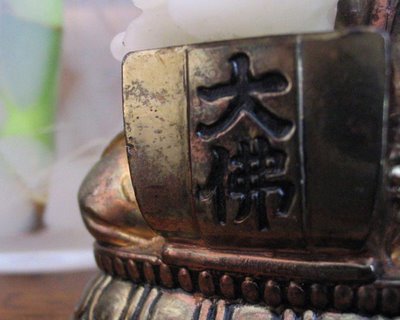 So on with the story. The first lesson usually given to newcomers, after they’ve been warned not to become too attached to the Buddha as a figurehead, is the story of the historical Buddha.
So on with the story. The first lesson usually given to newcomers, after they’ve been warned not to become too attached to the Buddha as a figurehead, is the story of the historical Buddha.This story has been told many, many times and in many formats. Karen Armstrong does an excellent job in her biography, Buddha. Herman Hesse took it on in the book Siddhartha. In the movie Little Buddha, Bertolucci directs Keanu Reeves as the young Gautama. The story has been co-opted as a Christian tale, and even the Vatican now admits that Saint Jehosephat was actually the Buddha.
Many historical accounts of the life of Buddha are crowded with legendary and mythical material. In 1912, P. Lakshmi Narasu wrote The Essence of Buddhism, and the first chapter of his book became the first chapter of Dwight Goddard’s A Buddhist Bible. I never really cared much for the title of the 1938 book, in that it carried the connotation of being a “gospel,” but it was a very useful and very early translation into English of several important texts, and is also one of the first “serious” books on Buddhism that I read, after I outgrew Jack Kerouac and Alan Watts.
“Stripped of mythical embellishments,” Narasu wrote, “the principal events in the life of Gautama Buddha are easily told. He was born about the middle of the sixth century before the Christian era (563 B.C.) in Lumbini Park in the neighborhood of Kapilavastu,” which is in what is now Nepal. Armstrong notes that recent scholarship indicates he might have been born as late as 479 B.C. Interestingly, 479 BC was the year Confucius died in China; it was also the height of the Greek civilization (Socrates, Pythagoras and Sophocles all lived during this time). The more-or-less simultaneous existence of figures like the Buddha, Confucius and Socrates have led some to call this period the “Axial Age,” but there’s no need to concern ourselves with this apparent synchronicity at this time.
“At Kapilavastu,” Narasu continues, “resided the chiefs of the Sakya clan, of whom little would be remembered had not Siddartha been born among them. Gautama’s father, Suddhodana, and his mother, Maya, the daughter of Suprabuddha, belonged to this clan.” As if the names “Siddhartha” and “Gautama,” weren’t enough to identify the historical Buddha, he has also been called “Sakyamuni,” or “Sage of the Sakyas,” an honorific title. And after his enlightenment, he referred to himself as “the Tathagatha” (the “thus come one”). So, from here on, any mention of Siddhartha, Gautama, Sakyamuni or the Tathagatha, or any derivation of those names (such as “Siddartha” and “Gotama”), all refer to the man known to the world as “the Buddha.”
“The mother of Siddartha died seven days after his birth. Under the kind care of his maternal aunt, Prajapati Gautami, Siddartha spent his early years in ease, luxury and culture. No pains were spared to make the course of his life smooth. At the age of sixteen, he was married to his cousin, Yasodhara, the daughter of the chief of Koli, and they had a son named Rahula.”
The name “Rahula,” Armstrong notes, has traditionally been understood to mean “fetter,” although some modern scholarship has questioned this derivation. Young prince Siddhartha apparently felt no pleasure when the child was born. The baby, he believed, would shackle him to a way of life that had become abhorrent, although all his life Siddhartha saw only the pleasant and the beautiful.
“About this time,” Narasu writes, “the sorrows and sufferings of mankind affected him deeply, and made him reflect on the problem of life. Impelled by a strong desire to find the origin of suffering and sorrow and the means of extirpating them, be renounced at the age of twenty-nine all family ties and retired to the forest, as was the wont in his day.”
Right from the start, Siddhartha took it for granted that family life was incompatible with the highest forms of spirituality. It was a perception shared not only by the forest monks and other ascetics of India, but also by Jesus, who would later tell potential disciples that they must leave their wives and children and abandon aged relatives if they wanted to follow him (Luke 9:57-62; 14:25-27; 18:28-30).
Siddhartha would not, Armstrong notes, have agreed with our current cult of family values; by one definition, you could have called him a “Dead-Beat Dad.” But before you get too harsh in your judgment, consider the dual facts that he was a Prince and left his wife and son to the generous care of the kingdom, and that he was not leaving for a more pleasurable life elsewhere, but rather a life of hardship and intense spiritual struggle that ultimately almost killed him.

No comments:
Post a Comment